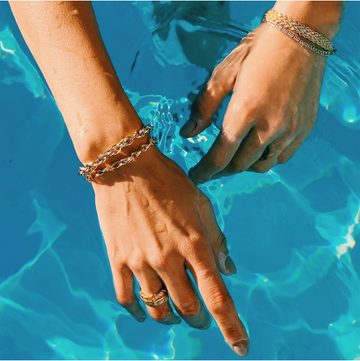Don’t have jewelry cleaner on hand? No problem! Your pantry is likely stocked with surprisingly effective alternatives that can restore the sparkle to your precious pieces. While professional cleaning is always a good idea, these simple DIY methods can help you maintain your jewelry’s brilliance between visits to the jeweler.
Important Considerations Before You Begin:
- Know Your Jewelry: Different materials react differently to various cleaning agents. Always identify the type of metal and gemstones in your jewelry before proceeding.
- Gentle is Key: Avoid harsh scrubbing or abrasive materials that could scratch or damage your jewelry.
- Test in a Hidden Area: If you’re unsure about how a cleaning method will affect your jewelry, test it on a small, inconspicuous area first.
- Avoid These Ingredients: Never use bleach, chlorine, or ammonia on jewelry, as these harsh chemicals can cause significant damage.
DIY Cleaning Powerhouses: Common Household Items to the Rescue:
1. Dish Soap and Warm Water: The Gentle Go-To
- What It Cleans: This method is safe and effective for most jewelry types, including diamonds, gold, platinum, and many gemstones.
- How It Works: Mild dish soap gently removes dirt, oils, and everyday grime without being too harsh.
-
How to Use:
- Mix a few drops of mild dish soap with warm water in a bowl.
- Soak your jewelry for 15-20 minutes.
- Gently scrub with a soft-bristled toothbrush (dedicated to jewelry cleaning) to reach crevices and settings.
- Rinse thoroughly under warm running water.
- Pat dry with a soft, lint-free cloth.
2. Baking Soda Paste: Banishing Stubborn Tarnish (Use with Caution!)
- What It Cleans: Effective for removing tarnish and stubborn grime, especially on gold and silver.
- How It Works: Baking soda is a mild abrasive that gently scrubs away tarnish and surface stains.
-
How to Use:
- Mix a small amount of baking soda with water to form a thick paste.
- Apply the paste to the jewelry with a soft cloth or toothbrush.
- Gently rub the paste onto the jewelry, focusing on tarnished areas.
- Rinse thoroughly with warm water.
- Pat dry with a soft, lint-free cloth.
- Important Note: Use this method with extreme caution and avoid it altogether on delicate gemstones like pearls, opals, and treated stones, as it can scratch or damage their surfaces.
3. White Vinegar Solution: Dissolving Residue (Handle with Care!)
- What It Cleans: Helps dissolve stubborn residue, soap scum, and hard water deposits.
- How It Works: The mild acidity of vinegar can break down these build-ups.
-
How to Use:
- Mix equal parts white vinegar and water in a bowl.
- Soak your jewelry for 10-15 minutes.
- Rinse thoroughly with warm water.
- Pat dry with a soft, lint-free cloth.
- Important Note: Vinegar can be harsh on some materials. Avoid using it on porous gemstones like pearls and opals, and test on a hidden area first if you’re unsure.
4. Aluminum Foil, Baking Soda, and Salt: Silver Tarnish Vanishing Act!
- What It Cleans: Specifically designed for removing tarnish from silver jewelry.
- How It Works: This method creates a chemical reaction called ion exchange that transfers the tarnish (silver sulfide) from the jewelry to the aluminum foil.
-
How to Use:
- Line a glass or ceramic dish with aluminum foil, shiny side up.
- Add 1 tablespoon of baking soda and 1 teaspoon of salt to the dish.
- Pour in enough boiling water to cover the jewelry.
- Place your silver jewelry in the dish, ensuring it touches the aluminum foil.
- Let it soak for 5-10 minutes. You should see the tarnish transfer to the foil.
- Remove the jewelry and rinse thoroughly with warm water.
- Pat dry with a soft, lint-free cloth.
- Important Note: This method is not suitable for jewelry with gemstones. It is best to not use any type of abrasive or solutions on the gems to clean tarnished silver.
General Tips for Success:
- Always Use a Soft-Bristled Brush: An old toothbrush (dedicated solely to jewelry cleaning) is ideal for reaching crevices and settings.
- Rinse Thoroughly: Always rinse your jewelry thoroughly with warm water after cleaning to remove any residue from the cleaning solution.
- Dry Carefully: Pat dry with a soft, lint-free cloth. Avoid air-drying, as water spots can form.
- Store Properly: Store your jewelry in a clean, dry place, ideally in a jewelry box or pouch, to prevent tarnish and scratching.
By utilizing these common household items with caution and care, you can keep your jewelry sparkling and beautiful. However, remember that professional cleaning is still recommended for valuable or delicate pieces and for deep cleaning.







